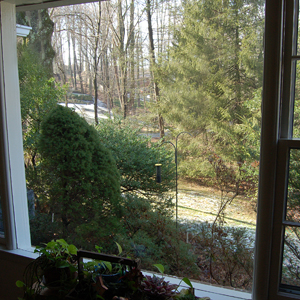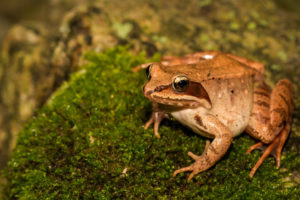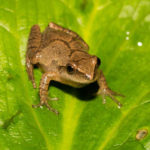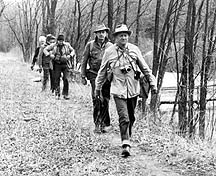View From
Rachel’s Window

Protecting Frogs’ Habitats for Their Services and Their Songs
From Rachel’s study window you can see the wooded section of her property where spring brings forth overhead a red haze of maple flowers, and from below snow drops, daffodils, Jack in the Pulpit, the ephemeral Virginia Bluebells, and this year in late February, the special sound of Wood Frogs (Rana sylvatica). In order to preserve the wildness, Rachel Carson designated a third of her property to be undeveloped and wet underfoot as a fitting habitat for birds and frogs.
At the property’s edge is a trickling stream. Checking the area for life in February, a resident was rewarded with the sight of Wood Frogs around a shallow pool. At the same time their ducklike, cackling calls were heard. Days later, rafts of frog eggs were observed in the water. Their successful development would contribute to the area’s biodiversity bringing with it a sense of wonder as delightful to today’s families as it was to Rachel Carson 60 years ago.
Wood Frogs are also thriving in the wetlands along the C&O Canal in Potomac, Maryland. On a late February day, their calling was so clamorous that some walkers on the towpath stopped and tried to find the source of the unfamiliar sound. Believing it to originate with ravens or ducks, some stared into the woods hoping to catch sight of the noisy flock. A happy few were informed by fellow walkers that this exuberant sound originated from the yearly gathering of 3 inch long Rana sylvatica. The Wood Frogs’ calling is in conjunction with mating and lasts from a few days to a week. These cold blooded first frogs of the spring possess not only a distinctive call but also the amazing ability to protect themselves from subfreezing temperatures. Their range extends northward to Labrador, Alaska and the Yukon (where Wood Frogs are the only North American amphibian to be found).
Another frog sound heard at this time of year comes from Spring Peepers, Pseudacris crucifer. This frog, half the size of Rana sylvatica, has a bell-like call described as a “nearly pure-tone whistle or peep that rises slightly in pitch from beginning to end.”(Elliot, Gerhardt, Davidson, Frogs and Toads of North America, 2009). In the late 1950s when Rachel Carson came to live in her White Oak home the Spring Peepers were so abundant that she and Roger (her adopted son) could barely hear themselves speak as they walked on the road near their house. Carson made tape recordings from the calls and sent them to distant friends. She celebrated hearing the sounds as a sense of wonder experience. Spring Peepers are also singing regularly at this time of year in wetlands along the C&O Canal.
The Chesapeake & Ohio National Historical Park
The towpath along the C&O Canal was one of Rachel Carson’s favorite hiking places. There she could experience nature’s wonders and exchange information with other hikers. Today, we all can still share the privilege of walking in the footsteps of Rachel Carson and thousands of others thanks to U.S. Supreme Court Justice, William O. Douglas. In 1954 he read a Washington Post editorial backing the plan to build a highway over or alongside the historic canal. Incensed, he openly challenged the editorial writers to walk with him the entire length of the canal, 184 miles. The walk took place generating considerable positive publicity for preserving the Canal and its towpath. The newspaper reversed its stand. President Eisenhower designated the Canal a national monument. Years later in 1971, President Nixon signed legislation to make the site a national historic park. (Sullivan, P., “Milestone hike ensured legacy of C&O Canal,” Wash Post, 9-19-14)
Potential Threats to Frog Habitat And Attempts to Limit Them
The Canal is flanked by wetlands on both sides: on one side by the Potomac River and on the other by small streams and beyond the Park’s land, by private property. With development of properties abutting the Park these streams may become contaminated or diverted making the habitat less desirable for amphibians.
In 2015, to help preserve and protect small streams and wetlands (in Maryland and throughout our nation), the Obama administration’s USEPA, and the Army Corps of Engineers jointly added the “clean water rule” to the 1972 Clean Water Act allowing the federal government to limit pollution and draining of previously unprotected streams and wetlands (that together constitute 60% of the nation’s bodies of water). The 2015 “clean water rule” has yet to be implemented (“a federal court delayed it as the judges review a legal case against it”) This “rule” has come under fierce attack by business interests including: developers, fertilizer and pesticide makers, golf course owners, and others, who claim it will intrude on property owners’ rights. President Trump also opposes the 2015 “clean water rule.” (Davenport, C., “Trump Order Will Aim to Roll Back Clean Water Rule,” The New York Times, 2-28-17). Supporting the 2015 “clean water rule” are environmental groups, recreational groups, hunters, and sport fishermen (Eilperin, J, & A. Phillip, “Trump tells agencies to revisit EPA rule from Obama era,” Wash Post, 3-1-17). The “clean water rule” if allowed to stand and if enforced would especially benefit fish and amphibians.
What You can Do to Help Frogs
Frogs need clean water habitats to find food, escape predators and reproduce.
Loss of frog habitat from chemical deterioration* and/or drainage of wetlands and small streams remains an important long-term threat, that enforcement of the clean water rule could help avoid. We as individuals can do something about habitat loss. This year one way to help frogs and other wildlife at risk from deteriorating aquatic resources is to contact government officials to express our support for the 2015 “clean water rule” and our opposition to any effort to weaken or abolish it.
“Preserving your local stream or wetland is one of the best things you can do for frogs…” (Elliot, Gerhardt, Davidson, Frogs and Toads of North America, 2009).
Frogs’ Ecological Services
In return for our protection of their habitats, frogs provide many benefits: Frogs are important links in the freshwater food chain. Their diet includes mosquitoes and other pest insects plus various snails and spiders. On the other hand a variety of birds, mammals and other reptiles feed on the frogs. And of course, during the early spring they continue to provide us as they have since prehistoric times with their special songs:
“… a primeval…sort of wilderness music…one of the most ancient sounds of the earth [from] millions of years ago…” (quote from Sigurd Olsen in Elliot, Gerhardt, Davidson, Frogs and Toads of North America, 2009).
By Diana Post and Munro Meyersburg
February/March 2017
*Chemical pesticides singly and in mixtures, even at low concentrations, have been associated with adverse effects in frogs. Along with toads, they have been designated as early indicators of environmental health problems or “canaries in the coal mine.” The adverse effects in frogs include abnormal reproductive organs, decreased immune response, behavioral changes, and physical deformities. The herbicides atrazine, glyphosate, and paraquat as well as the insecticides DDT, malathion, diazinon, and the combination of malathion and esfenvalerate are some of the chemicals associated with adverse effects in frogs. When chemical pesticides are used in landscaping, lawn chemical runoff can contaminate frog habitat. Similarly, agricultural chemical runoff can be hazardous to frogs and other amphibians. Chemical pollution, habitat destruction, climate change, and disease have resulted in a serious worldwide reduction in amphibian populations. (Note: the examples provided are not a complete catalog of pesticide hazards to frogs.)





